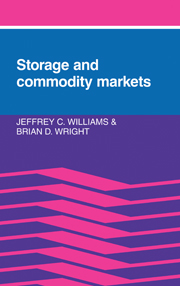Book contents
- Frontmatter
- Contents
- Preface
- Acknowledgments
- 1 Introduction
- Part I The basic model
- Part II Implications of storage for research on time series
- Part III Extensions of the model
- 8 The market's reaction to news
- 9 The interaction of storage and trade
- 10 Inventories of raw materials, finished goods, and goods in process
- 11 Market power and storage
- Part IV Public interventions
- Part V Epilogue
- References
- Author index
- Subject index
8 - The market's reaction to news
Published online by Cambridge University Press: 03 February 2010
- Frontmatter
- Contents
- Preface
- Acknowledgments
- 1 Introduction
- Part I The basic model
- Part II Implications of storage for research on time series
- Part III Extensions of the model
- 8 The market's reaction to news
- 9 The interaction of storage and trade
- 10 Inventories of raw materials, finished goods, and goods in process
- 11 Market power and storage
- Part IV Public interventions
- Part V Epilogue
- References
- Author index
- Subject index
Summary
During the oppressive heat and dryness in grain-producing regions of the United States in the summer of 1988, many believed in the arrival of the “greenhouse effect.” The grain markets, more dispassionate than journalists, seem not to have given much credence to the cries of alarm over the possibility of long-run global warming and environmental degradation. If the typical weather were known to be ever worsening, the prices of corn and soybeans for delivery in later cropyears would be above the price for delivery in 1988. The actual price pattern was one in which the quoted price for delivery after the harvest of 1989 was not far above the average over the previous decade. Specifically, on May 1, 1988, during planting and before any indications of severe drought, the price of soybeans on the Chicago Board of Trade for delivery in July 1988 was $6,985 per bushel; the November 1988 contract, the first delivery month for the crop that would suffer from the weather, was $7,135. The November 1989 contract was not yet traded, but based on other contracts one can infer that it would have had a price in the range of $7.30 to $7.40. On June 22, 1988, soybean prices were near their peak, as a result of the poor weather (and prospects for more of the same). On that day, the price for July 1988 delivery was $10,545, an increase of 50 percent from May 1. Although the price for November 1988 delivery was up by a similar percentage, the November 1989 contract was trading for $7.55, an increase of 3 percent at most.
- Type
- Chapter
- Information
- Storage and Commodity Markets , pp. 201 - 228Publisher: Cambridge University PressPrint publication year: 1991



